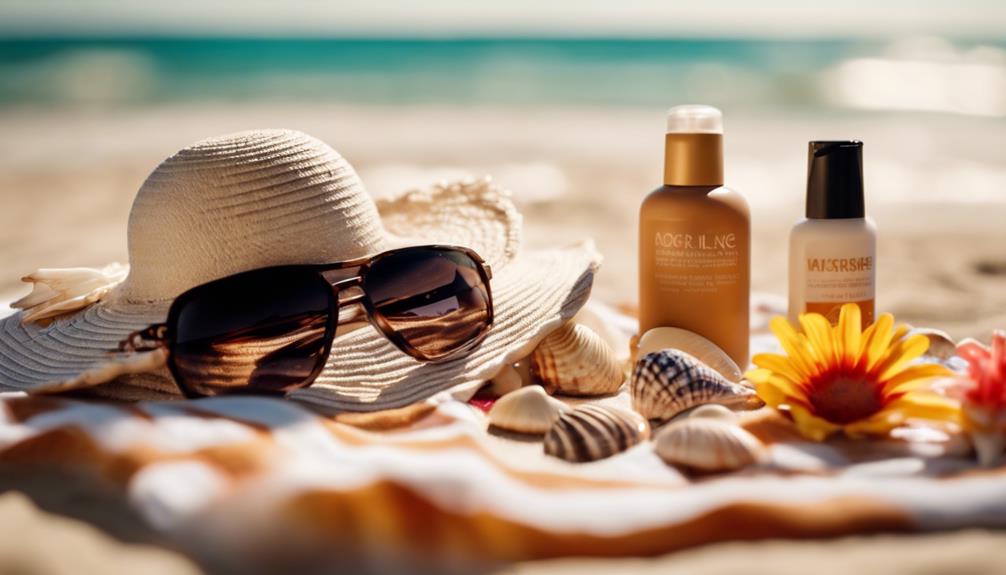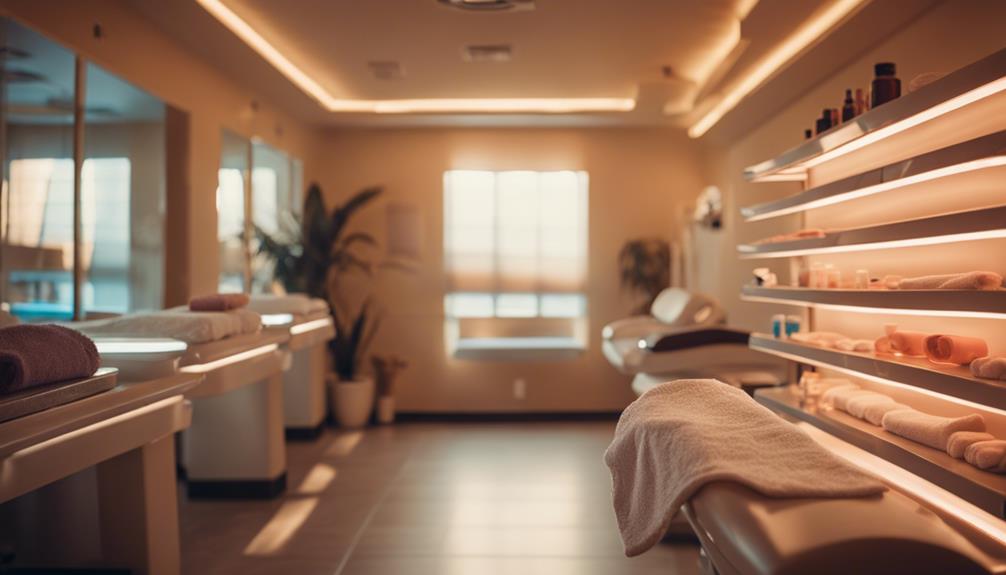To become an expert in safe tanning, you should first understand your skin type and how it responds to UV exposure. Select the appropriate tanning bed based on your skin’s sensitivity, and remember to wear protective eyewear. When choosing bronzer lotions, opt for one that complements your skin tone for optimal results. Start your tanning sessions with shorter time periods and gradually increase as your skin adjusts. Monitor any reactions and focus on post-tanning care with moisturizers and sunscreen. By following healthy practices, you can achieve a radiant glow while minimizing potential risks. There’s more to explore to improve your tanning regimen! It’s also important to educate yourself on the dangers of indoor tanning. Extended UV exposure can heighten the risk of skin cancer and premature aging. It’s essential to limit tanning sessions and prioritize the health and safety of your skin. By staying informed and taking necessary precautions, you can enjoy a healthy glow without compromising your well-being. Remember, preserving your overall health is more important than achieving a tan.
Key Takeaways
- Assess your skin type and UV sensitivity to tailor your tanning approach and minimize risks.
- Start with short tanning sessions (5-7 minutes) and gradually increase duration as your skin adjusts.
- Choose the appropriate tanning bed based on your skin type, prioritizing lower UV exposure for sensitive skin.
- Use protective eyewear during sessions and apply bronzer evenly for optimal results.
Understanding Your Skin Type
To achieve a safe and effective tan, it's important to first assess your skin type and how it reacts to UV exposure. Identify whether your skin tans easily or burns quickly; this knowledge helps tailor your tanning sessions.
If you have sensitive skin, you might want to start with shorter sessions and low UV exposure to avoid irritation. It's vital to monitor your skin's reactions during tanning to find the ideal balance for a healthy glow.
Consulting a dermatologist can provide tailored advice, especially if you have a family history of skin cancer. Remember, prioritizing your skin health alongside your tanning goals guarantees you maintain a radiant complexion while minimizing risks associated with UV exposure.
Choosing the Right Tanning Bed

Selecting the right tanning bed is essential for achieving your desired tan while ensuring your skin's safety and health.
Start by evaluating your skin type and sensitivity to UV rays. If you burn easily, opt for a bed with lower UV exposure to minimize the risk of damage.
Always consult professionals at tanning salons for recommendations tailored to your specific needs.
Familiarize yourself with the bed's features, such as the balance of UVA and UVB rays, which can influence your tanning speed and overall results.
Don't forget to wear protective eyewear during your sessions to safeguard your eyes.
Selecting Bronzer Lotions

Finding the right bronzer lotion can enhance your tanning experience and help you achieve a natural-looking glow that complements your skin type. When selecting a bronzer, consider your skin's needs and the desired results. Here's a quick guide to help you choose:
| Skin Type | Recommended Bronzer |
|---|---|
| Fair | Light gradual tanner |
| Medium | Medium bronzer with DHA |
| Olive | Dark bronzer for deeper tones |
| Dark | Rich, deep bronzer for a sun-kissed look |
Apply bronzer evenly for the best results, and remember to stay hydrated. Whether you're a beginner or experienced tanner, selecting the right bronzer lotion makes all the difference in achieving that perfect tan.
Establishing a Tanning Routine

Establishing a tanning routine helps you achieve a healthy glow while minimizing skin damage.
Start by evaluating your skin type and sensitivity to UV rays; this insight will guide your tanning sessions. If you're new to tanning, prep your skin by exfoliating and moisturizing to create an even canvas.
Use protective goggles during each session to safeguard your eyes. Begin with shorter sessions, around 5-7 minutes, and gradually increase the time as your skin adapts.
Experiment with different tanning beds to find what works best for you, focusing on those that balance UVA and UVB rays.
Regularly monitor your skin's reaction and adjust your routine accordingly to maintain a safe and effective tanning experience.
Safe Tanning Duration for Beginners

Starting with shorter tanning sessions, typically around 5-7 minutes, is essential for beginners to prevent overexposure and skin damage.
As your skin adapts, you can gradually increase the duration by a few minutes each session. Pay attention to how your skin reacts; if you notice any redness or irritation, it's a sign to cut back.
Always use protective goggles to shield your eyes from harmful UV rays. Experiment with different tanning beds to find the one that suits your skin type and desired results best.
Essential Post-Tanning Care

Post-tanning care is essential for maintaining skin hydration and ensuring a radiant, even glow after your tanning sessions.
Start by applying a rich moisturizer to replenish moisture and reduce the appearance of dead skin cells. This will nourish your skin and prolong your tan.
Don't forget to protect your lips; use a lip balm with SPF to prevent chapping and sunburn.
After tanning, apply sunscreen to any exposed areas to avoid uneven skin tone.
It's also wise to limit your tanning sessions to minimize potential skin damage.
Finally, consider using tan extenders to maintain your glow and keep your skin looking smooth and radiant.
Consistent aftercare is key to achieving the best results from your tanning experience.
Healthy Tanning Practices

Maintaining healthy tanning practices not only enhances your glow but also protects your skin from potential damage. To achieve a beautiful tan safely, follow these essential tips:
- Assess Your Skin Type: Know your skin's sensitivity to UV rays. If you're unsure, consult a dermatologist for personalized advice.
- Limit Session Duration: Start with short tanning sessions, around 5-7 minutes, especially if you're new to tanning. Gradually increase as your skin adapts.
- Prioritize Hydration: Keep your skin moisturized before and after tanning to maintain its health and prolong your tan.
Frequently Asked Questions
How Often Should I Tan to Avoid Skin Damage?
To avoid skin damage, limit tanning sessions to once or twice a week. Start with shorter durations, monitor your skin's reaction, and always prioritize hydration and aftercare to maintain a healthy, radiant appearance.
Can I Tan if I Have a Sunburn?
You shouldn't tan with a sunburn. Your skin's already damaged, and tanning could worsen the burn, leading to increased pain and potential long-term issues. Instead, focus on healing before considering any tanning.
Are There Any Foods That Enhance Tanning Results?
Certain foods can enhance tanning results. Incorporate carrots, sweet potatoes, and tomatoes into your diet; they're rich in beta-carotene and lycopene, which can improve skin tone and promote a healthy glow during your tanning process.
What Are the Signs of Tanning Bed Overexposure?
When your skin starts feeling like a sunburned ember, it's time to take heed. Signs of tanning bed overexposure include redness, peeling, excessive dryness, or discomfort. Listen to your skin; it knows best.
How Do I Choose the Right Time of Day for Tanning?
To choose the right time for tanning, aim for late morning or early afternoon when UV rays are strongest. Avoid peak sun hours and always listen to your skin's response to guarantee a safe experience.
Are there any potential risks or dangers associated with “flipping for tan” techniques?
Flipping for tan techniques can pose potential risks if not done carefully. It’s important to master flipping tan art to avoid uneven or streaky results, as well as overexposure to UV rays. Always use sunscreen and follow proper skin protection measures to minimize any dangers associated with tanning.
Conclusion
In summary, mastering the art of safe tanning is all about balance and knowledge.
Did you know that over 90% of skin cancers are linked to UV exposure? That's why understanding your skin type and following safe tanning practices is essential.
By taking the right steps and being mindful of your tanning routine, you can enjoy that sun-kissed glow while minimizing risks.
Embrace the beauty of a radiant tan, and always prioritize your skin's health!









